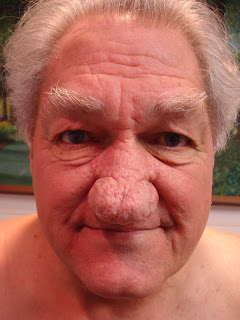The patient is a 73-year-old semi-retired carpenter who presents
for evaluation of lesions on his back and eyelids. Surprisingly, he did not mention his nose.
O/E: He has two epidermal inclusion cysts on the back some
and some small skin tags around the right upper and lower lids (these lesions were snip
excised).
More significantly, the skin of the distal nose it grossly thickened
and patulous.
Clinical Photos:
Diagnosis:
Rhinophyma, Grade 3.
Although he did not initially express concerns regarding his
nose, when I mentioned that there are treatments, the patient was very
interested.
References:
1. Basal cell carcinoma masked in rhinophyma.
2. Basal cell carcinoma and rhinophyma. Leyngold M et. al. Ann
Plast Surg. 2008 Oct;61(4):410-2.
Abstract: Rhinophyma, the end stage in the development of
acne rosacea, is characterized by sebaceous hyperplasia, fibrosis, follicular
plugging, and telangiectasia. Although it is commonly considered a cosmetic
problem, it can result in gross distortion of soft tissue and airway
obstruction. Basal cell carcinoma (BCC) is a rare finding in patients with
rhinophyma. The objective of this study is to review the literature of BCC in
rhinophyma and report on a case. A 70-year-old male presented with
long-standing rosacea that resulted in a gross nasal deformity. The patient
suffered from chronic drainage and recurrent infections that failed
conservative treatment with oral and topical antibiotics. The patient decided
to proceed with surgical intervention and underwent tangential excision and
dermabrasion in the operating room. Since 1955 there have been 11 cases
reported in the literature. In our case, the pathology report noted that the
specimen had an incidental finding of a completely resected BCC. The patient
did well postoperatively and at follow-up remains tumor-free. Despite the
uncommon occurrence of BCC in resection specimens for rhinophyma, we recommend
that all specimens be reviewed by a pathologist. If BCC is detected,
re-excision may be necessary and careful follow-up is mandatory. Larger studies
would be needed to determine the correlation between the 2 conditions.


I had a similar patient. He was 55 and had a 20 year history of uncontrolled granulomatous rosacea and rhinophma with active pustules. He developed a bcc on his nose. he did very well with low dose accutane 20 mg daily.
ReplyDelete